The Best Homemade Lasagna Recipe: Layers of Pure Comfort
Layering flavors with precision, this homemade lasagna captures the essence of comfort cooking.
Rich aromas waft through kitchens, promising a culinary adventure.
Generations of passionate cooks have perfected this classic Italian dish.
Cheese, pasta, and robust sauce create a harmonious symphony of taste.
Carefully assembled ingredients dance together in perfect balance.
Tender noodles embrace savory meat and creamy ricotta with delightful intensity.
Savor each bite and let the magic unfold on your plate.
Reasons to Love Homemade Lasagna
What You Need for Homemade Lasagna
Meat Base:Sauce Ingredients:Pasta and Cheese Components:Classic Homemade Lasagna Layering Steps
Step 1: Fire Up the Meaty Base
Create a rich sauce by browning ground beef and Italian sausage in a large skillet.
Add these ingredients:Crumble the meat while cooking and drain excess fat.
Pour in tomato ingredients and spices:Let the sauce simmer uncovered for 90 minutes, stirring occasionally to develop deep flavors.
Step 2: Prepare Perfect Pasta
Boil a large pot of salted water and cook lasagna noodles until tender.
Drain and set aside.
Step 3: Whip Up Creamy Cheese Blend
Mix together in a bowl:Combine ingredients until smooth and set aside.
Step 4: Build Stunning Layers
Preheat oven to 375°F.
Start by spreading a thin meat sauce layer in a 9×13 inch baking dish.
Create layers in this order:Repeat layering three times, finishing with meat sauce and extra Parmesan on top.
Step 5: Bake to Golden Perfection
Cover with foil and bake for 25 minutes.
Remove foil and continue baking another 25 minutes until cheese turns golden and bubbly.
Step 6: Rest and Serve
Allow lasagna to rest for 15 minutes before slicing.
This helps layers set and makes serving easier.
Lasagna Layering Tips You Can Trust
Reheat Homemade Lasagna Leftovers
Salads and Sides for Homemade Lasagna
Homemade Lasagna Layer Alternatives
FAQs
Draining excess fat prevents the lasagna from becoming greasy and helps concentrate the meat sauce flavors, creating a more rich and balanced dish.
Yes, no-boil noodles work great and save time. Just adjust the liquid content in the recipe slightly to ensure proper noodle hydration during baking.
The egg acts as a binding agent, helping the ricotta hold its shape and create a more cohesive, creamy cheese layer that doesn’t become watery during baking.
Absolutely. Resting allows the layers to set, makes cutting cleaner, and helps the lasagna maintain its structure when serving, preventing the layers from sliding apart.
Print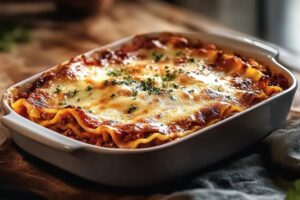
Homemade Lasagna Recipe
- Total Time: 2 hours 30 minutes
- Yield: 8 1x
Description
Layers of rich, savory homemade lasagna promise a culinary journey through Italian comfort food. Melted cheese, hearty meat sauce, and perfectly cooked pasta create a delightful experience you’ll savor with every delicious bite.
Ingredients
Meat and Protein:
- 0.5 pounds (226 grams) sweet Italian sausage
- 0.5 pounds (226 grams) lean ground beef
- 1 egg, beaten
Herbs and Seasonings:
- 1 tablespoon sugar
- 2 tablespoons fresh parsley, chopped
- 1 teaspoon dried basil
- 1 teaspoon Italian seasoning
- 0.5 teaspoon fennel seeds (optional)
- Salt and black pepper to taste
- 0.25 teaspoon salt
Vegetables and Aromatics:
- 1 medium onion, diced
- 2 cloves garlic, minced
Tomato Products:
- 1 (28 ounces/794 grams) can crushed tomatoes
- 1 (15 ounces/425 grams) can tomato sauce
- 1 (6 ounces/170 grams) can tomato paste
Cheese:
- 15 ounces (425 grams) ricotta cheese (or cottage cheese)
- 3 cups shredded mozzarella cheese
- 1 cup grated Parmesan cheese
Pasta:
- 12 lasagna noodles
Instructions
- Prepare the robust meat sauce by browning ground beef and Italian sausage with aromatic onions and garlic in a large skillet. Crumble the meat thoroughly during cooking and drain excess fat.
- Enhance the sauce with crushed tomatoes, tomato sauce, and tomato paste. Season generously with parsley, basil, Italian seasoning, fennel seeds, salt, and pepper. Allow the sauce to simmer uncovered, developing deep flavors for approximately 90 minutes, stirring periodically.
- Simultaneously, boil a pot of salted water and cook lasagna noodles until perfectly tender. Drain and set aside to prevent sticking.
- Craft the creamy cheese mixture by whisking ricotta with egg, chopped parsley, and a pinch of salt until smooth and well-incorporated.
- Preheat the oven to 375°F (190°C) and begin layering the lasagna. Create a thin sauce base in a 9×13-inch baking dish, then strategically layer noodles, ricotta mixture, mozzarella, and Parmesan cheese.
- Repeat the layering process three times, ensuring each layer is evenly distributed and ending with a generous topping of meat sauce and Parmesan cheese.
- Cover the lasagna with aluminum foil and bake for 25 minutes. Remove the foil and continue baking until the cheese turns golden and slightly bubbling.
- Allow the lasagna to rest for 15 minutes after baking, which helps the layers stabilize and makes cutting and serving more manageable.
Notes
- Select high-quality ground beef and Italian sausage for richer, more complex flavor profiles that elevate the entire dish.
- Allow meat sauce to simmer slowly, developing deeper taste by breaking down tomatoes and melding spices together perfectly.
- Slightly undercook lasagna noodles during boiling since they’ll continue cooking in the oven, preventing mushy texture and maintaining ideal al dente consistency.
- Layer ingredients evenly to ensure balanced taste and texture in every single bite, distributing cheese and sauce carefully across each layer.
- Prep Time: 30 minutes
- Cook Time: 2 hours
- Category: Dinner
- Method: Baking
- Cuisine: Italian
Nutrition
- Serving Size: 8
- Calories: 410
- Sugar: 6 g
- Sodium: 800 mg
- Fat: 22 g
- Saturated Fat: 10 g
- Unsaturated Fat: 8 g
- Trans Fat: 0 g
- Carbohydrates: 33 g
- Fiber: 2 g
- Protein: 25 g
- Cholesterol: 70 mg

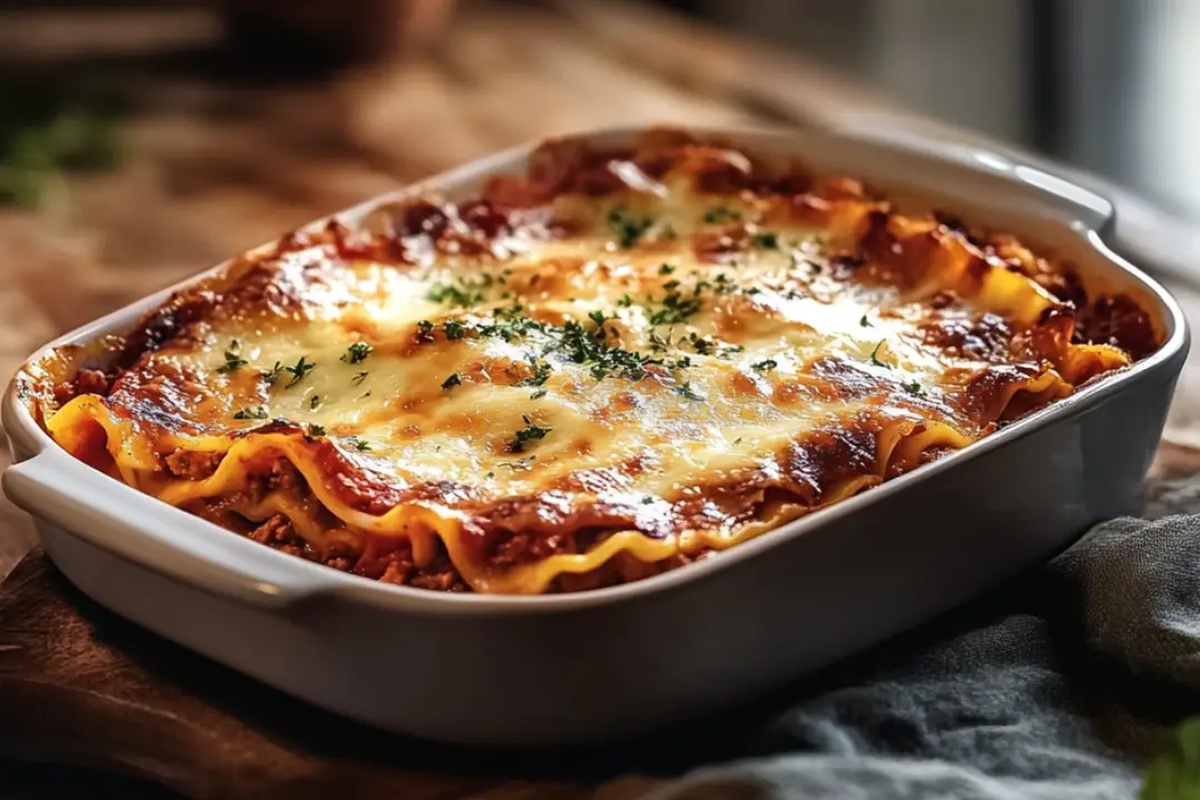
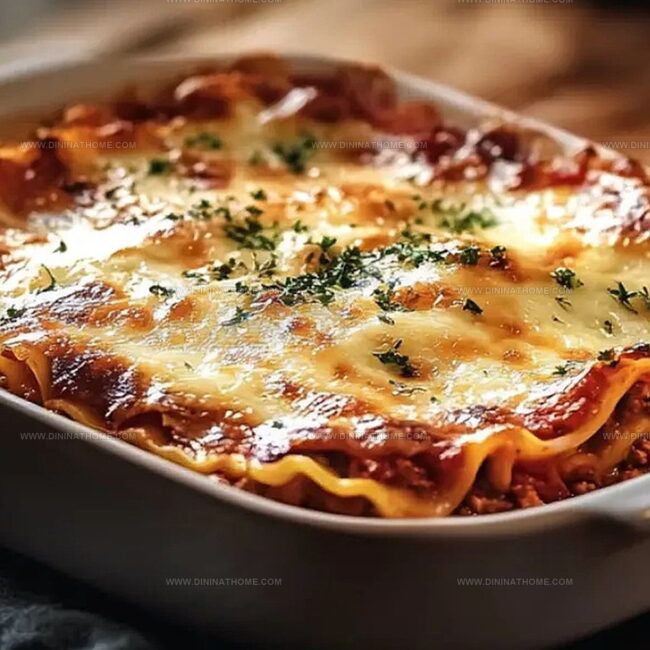
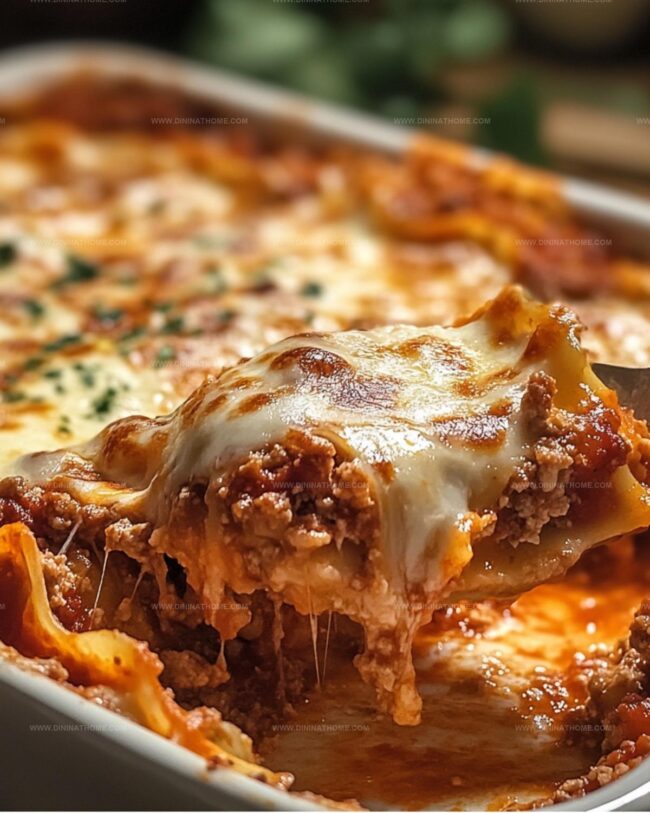
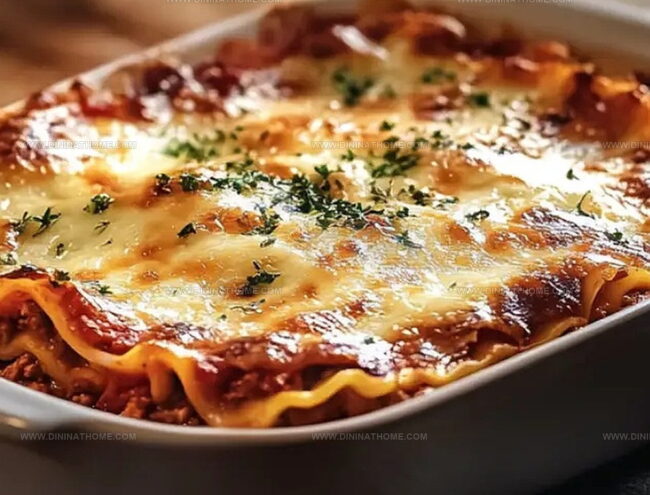
James Walker
Lead Recipe Developer & Culinary Educator
Expertise
Southern Cuisine & Farm-to-Table Cooking, Recipe Development & Testing, Culinary Education & Instruction
Education
School: Auguste Escoffier School of Culinary Arts
Program: Diploma in Culinary Arts and Operations
Focus: Comprehensive training in classical and modern culinary techniques, kitchen operations, and farm-to-table practices.
James didn’t learn cooking from a TV show, he learned it from busy kitchens, family gatherings, and long afternoons spent testing recipes the hard way.
After training at the Auguste Escoffier School of Culinary Arts, he brought his love for real, down-to-earth food to every dish he makes.
At Dining At Home, James loves building recipes that feel familiar but still have something special, like adding a twist to a classic or making a slow Sunday dinner feel brand new.
When he’s not in the kitchen, you’ll probably find him swapping garden tips at the farmers’ market or teaching his daughter how to flip pancakes without a mess (almost).